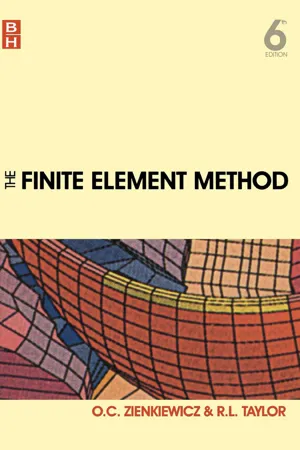
The Finite Element Method: Its Basis and Fundamentals
- 752 pages
- English
- ePUB (mobile friendly)
- Available on iOS & Android
The Finite Element Method: Its Basis and Fundamentals
About this book
The Sixth Edition of this influential best-selling book delivers the most up-to-date and comprehensive text and reference yet on the basis of the finite element method (FEM) for all engineers and mathematicians. Since the appearance of the first edition 38 years ago, The Finite Element Method provides arguably the most authoritative introductory text to the method, covering the latest developments and approaches in this dynamic subject, and is amply supplemented by exercises, worked solutions and computer algorithms.• The classic FEM text, written by the subject's leading authors • Enhancements include more worked examples and exercises• With a new chapter on automatic mesh generation and added materials on shape function development and the use of higher order elements in solving elasticity and field problemsActive research has shaped The Finite Element Method into the pre-eminent tool for the modelling of physical systems. It maintains the comprehensive style of earlier editions, while presenting the systematic development for the solution of problems modelled by linear differential equations. Together with the second and third self-contained volumes (0750663219 and 0750663227), The Finite Element Method Set (0750664312) provides a formidable resource covering the theory and the application of FEM, including the basis of the method, its application to advanced solid and structural mechanics and to computational fluid dynamics.- The classic introduction to the finite element method, by two of the subject's leading authors- Any professional or student of engineering involved in understanding the computational modelling of physical systems will inevitably use the techniques in this key text
Frequently asked questions
- Essential is ideal for learners and professionals who enjoy exploring a wide range of subjects. Access the Essential Library with 800,000+ trusted titles and best-sellers across business, personal growth, and the humanities. Includes unlimited reading time and Standard Read Aloud voice.
- Complete: Perfect for advanced learners and researchers needing full, unrestricted access. Unlock 1.4M+ books across hundreds of subjects, including academic and specialized titles. The Complete Plan also includes advanced features like Premium Read Aloud and Research Assistant.
Please note we cannot support devices running on iOS 13 and Android 7 or earlier. Learn more about using the app.
Information
Table of contents
- Cover image
- Title page
- Table of Contents
- Copyright
- Dedication
- Preface
- 1. The standard discrete system and origins of the finite element method
- 2. A direct physical approach to problems in elasticity: plane stress
- 3. Generalization of the finite element concepts. Galerkin-weighted residual and variational approaches
- 4. ‘Standard’ and ‘hierarchical’ element shape functions: some general families of C0 continuity
- 5. Mapped elements and numerical integration – ‘infinite’ and ‘singularity elements’
- 6. Problems in linear elasticity
- 7. Field problems – heat conduction, electric and magnetic potential and fluid flow
- 8. Automatic mesh generation
- 9. The patch test, reduced integration, non-conforming elements
- 10. Mixed formulation and constraints – complete field methods
- 11. Incompressible problems, mixed methods and other procedures of solution
- 12. Multidomain mixed approximations – domain decomposition ‘frame’ methods
- 13. Errors, recovery processes and error estimates
- 14. Adaptive finite element refinement
- 15. Point-based and partition of unity approximations. Extended finite element methods
- 16. The time dimension – semi-discretization of field and dynamic problems and analytical solution procedures
- 17. The time dimension – discrete approximation in time
- 18. Coupled systems
- 19. Computer procedures for finite element analysis
- Appendix A: Matrix algebra
- Appendix B: Tensor-indicial notation in the approximation of elasticity problems
- Appendix C: Solution of simultaneous linear algebraic equations
- Appendix D: Some integration formulae for a triangle
- Appendix E: Some integration formulae for a tetrahedron
- Appendix F: Some vector algebra
- Appendix G: Integration by parts in two or three dimensions (Green’s theorem)
- Appendix H: Solutions exact at nodes
- Appendix I: Matrix diagonalization or lumping
- Author index
- Subject index